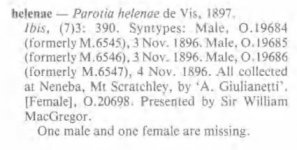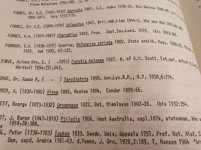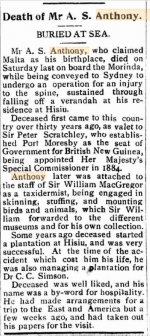Sorry, but I simply couldn't keep my fingers away from ...
• the Eastern Parotia
Parotia helenae DE WIS 1897, as "
Parotia helenæ", a k a Helena's Parotia, or Helena's Six-wired Bird-of-Paradise (alt. even 'Eastern Lawes's Parotia', by those who consider, alt. considered , it a ssp.; '
Parotia lawesii helenae')
Two issues here:
1) It was Rothschild's opinion that the holotype skin was NOT collected by MacGregor nor by Giulianetti but by A.S. Anthony ...
Sorry Paul, I'm not sure I agree, where did you find/read the information of Rothschild's opinion about the "holotype skin" itself
?!?
With this said, even if I haven't been able to determine (with a 100% certainty) who truly collected the Type/s, but I tend to believe that the collector (in 1896) was Mr. Amedeo Giulianetti (who worked for Sir William Macgregor), exactly as told by Charles W. de Vis himself (in the very OD).
As I see it "Rothschild's opinion" (in 1903) was regarding the specimens kept at/in the Tring collection (England) ... as I read that certain part/article
* Rothschild wrote only about the skins "at present in our possesion", and from what I can tell he didn't write anything about the "holotype", of "
Parotia helenae De Vis". And note that it's not to be seen in the BNHM's
Bird type specimens database, like other 'similar' specimens (as for example/s,
here or
here); "Presented by the Queensland Museum".
Also, note that most of de Vis's specimens ended up in the
Queensland Museum, Australia. For example, see Ingram's Arcticle/Paper
Avian Type Specimens in the Queensland Museum, in Memoirs of the Queensland Museum 25, from 1987 (
here), or the excerpt below, and note his choice of words: "all":

Or do you mean that Rothschild actually had that certain specimen, the male one, today "missing", from/in the Queensland Museum collection?
However, it doesn't seem to solve the Etymology itself, about whom the dedicatee might be in the Eastern Parotia (Bird-of-Paradise)
Parotia helenae DE VIS 1897, as I see it we're still stuck, just as we were back in 2016, with either the Princess or Miss Scott/Mrs Forde.
Though, and this I have to admit (again, just like in post #2, from back in 2016). I find it somewhat disturbing that the OD doesn't include a clear and out-spoken dedication,
if dedicated to a Royal princess (even more so
if Sir MacGregor truly was a "rabid royalist ", like Paul put it), simply as most dedications (that we've seen earlier) aimed at certain Royals almost always have been both long and lingering, often somewhat oily and clearly ingratiating, from a 'humble and obedient servant' (that is
if MacGregor himself was involved, personally, in coining this name, of course).
Either way, to me, this far the shady and obscure; Helen/e/a or even Elena (alt. similar versions of her name) remain in the Dusk, as nothing but an undetermined or still non-identified Lady (contemporary, or not). That is if it's an Eponym at all, of course?
Either way, this far, I'd keep the explanation of this Eponym open, just like Phil Gregory did, in his book
Birds of Paradise and Bowerbirds (Helm, 2019),
here (even if I myself would have written the name of the first suggested, possible dedicatee as Miss Scott/Mrs Ford
e,

(and that is also; regardless if she, or he, ever was a "true" oologist, or not).
Good luck solving it!
Björn
PS. Or maybe it simply isn't an Eponym!?! Could it possibly be a Toponym
?!?
If so, it would/could explain why de Vis coined/used this name without any explanation/dedication what-so-ever. As we've seen other examples when the -ae ending has been used (without any other explanation) for different locations, one might wonder if there could be a map (or text) where the type location "... , Mt. Scratchley" was called
Mount Helen alt.
Mt. Helene, or
Mt. Helena... ? Or a nearby Hill, Creek, Valley, etc., etc., close to "Neneba, Mt. Scratchley"? Take it for what it's worth, if anything at all, as a suggestion, a possibility, it's just an idea, that suddenly struck me.
Either way, more info on the self-willed, and/but zealous C. W. de Vis
** himself, see the Special Issue of Memoirs of the Queensland Museum 28 (1), titled;
Proceedings of the de Vis Symposium (
here alt.
here), from 1990.
/B
*The very first part of Rothschild's (and Hartert's) Paper on 'Papuan Birds' started in 1901 (here).
**i.e. Charles Walter de Vis (1829–1915, born Devis, a name/spelling that he kept and used until 1882), a k a "Thickthorn" (as Pen name/Pseudonym).
For ALL taxa (many hundreds!) described by him see Appendix 1 (here; pp. 12-22).







